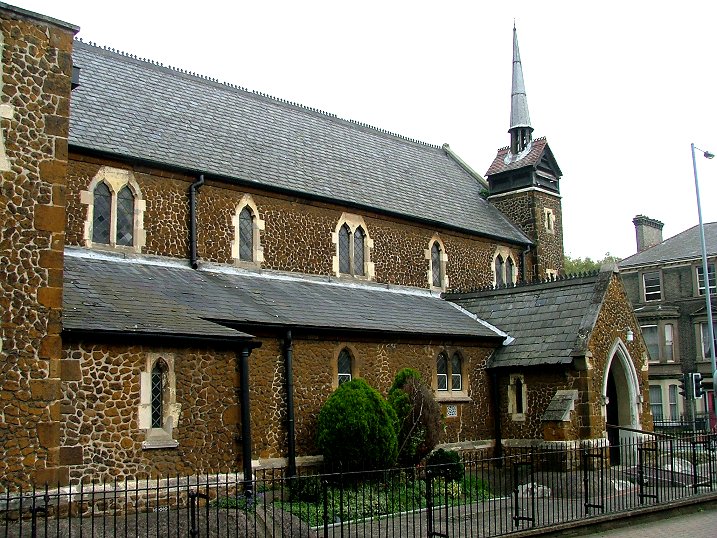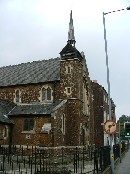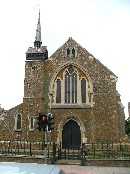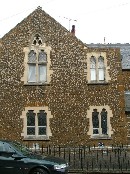| |
|
The
Annunciation, Kings Lynn
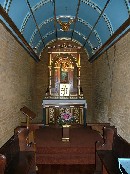 |
|
Kings
Lynn is a fascinating town, with a couple of
Norfolk's finest churches at its heart; but the
Catholic parish church of the Annunciation is
away from all that, a quiet little 1890s building
set apart from the town centre, on the busy road
to London. Indeed, this area is so urban and so
battered that it might even be in
London; some back street in Peckham or Tottenham
perhaps. The Annunciation, with its jaunty
spirelet, gives the street some much needed
character. Its rough carstone walls give it a
sense of the exotic, to my East Anglian eyes. A
relatively undistinguished building, then. But
the Church of the Annunciation has a great
significance for English Catholics, out of all
proportion to its architectural importance. For
here it was that, 360 years after the Reformation
that destroyed it, the Shrine of Our Lady of
Walsingham was re-established, and Marian
pilgrimage brought back to England.
|
The
original building on this site was much smaller, by
Augustus Pugin no less; it was the 1845 commission of
Father John Dalton, Lynn's Priest at the time of the
lifting of the penal laws. There was not a huge
congregation; the parish, which covered the whole of
north west Norfolk, had, according to the Lynn Advertiser
of the time, less than 150 Catholics all told, and
all of them poor. However, the future of this parish
and its church would be dramatically shaped by two small
villages that lay within it. One of them was Walsingham;
the other, Sandringham.
In the
later years of the 19th century, the Prince of Wales,
later to become Edward the VII, bought the vast
Sandringham estate, and built his dream home on it. It
became his favourite residence, both before and after he
was crowned King. It was where he entertained his guests.
Being a great cosmopolitan, many of his guests were
foreign; and, of course, this meant that most of them
were Catholics. To attend Mass, they had to come here, to
Kings Lynn; but the condition of the little 1845 church
gave great discomfort, and cause for concern. The Prince,
who was a great benefactor to medieval churches in this
part of Norfolk, got together in 1888 with Parish Priest
Father George Wrigglesworth to discuss ways of improving
the facilities.
The Prince
of Wales paid for a full survey of the church - and it
was found to be falling down. As with so many buildings
in this part of Norfolk, the foundations were adrift in
the soft, marshy ground. It became imperative that a new
church be built, and the Prince contributed fifty guineas
(about ten thousand pounds in today's money) to start
funds rolling.
But this
was a poor parish, and in the end the Diocese of
Northampton had to step in, partly out of embarrassment
perhaps, and the building of a new church got underway.
It was completed in February 1897, the work of the
architect Walter Lynn.
George
Wrigglesworth was a great antiquarian, and he seized the
opportunity to enhance the building with something that
was dear to his heart. In medieval times, England's
greatest site of pilgrimage was at Walsingham Abbey, some
20 miles away, and in the Annunciation parish. Many
pilgrims came ashore at Lynn, and the Red Mount chapel,
where they would hear their first Norfolk Mass before
setting off on the remainder of their journey, still
survives. The shrine had been destroyed by the Anglicans
in 1536, and Walsingham had fallen back into the
doldrums. But in its heyday, its streets had been alive
and full of colour with processions, celebrations,
hostelries and souvenir shops. Could something of that
devotional life be brought back to the streets of 19th
century Lynn?
The little
chapel forms a small aisle to the south of the sanctuary
- it is tiny, little more than a vaulted tunnel.
Wrigglesworth bought a statue of the Blessed Virgin and
child from Oberammagau, and on its arrival at Kings Lynn
railway station it was met with great ceremony and
rejoicing. Hundreds of people carried it around the Red
Mount chapel and then to the church of the Annunciation,
where it was enthroned. Fifteen lamps were lit to burn in
front of it, one for each mystery of the rosary. The
chapel was enclosed with a little wooden screen in the
15th century style.
The
procession became an annual event, and seems to have
become a part of the life of this lovely, welcoming town.
Coincidentally at this time, Charlotte Boyd, a
parishioner and convert from Anglicanism, found herself
in a position to buy the so-called Slipper Chapel, a
small medieval building at Houghton St Giles on the
outskirts of Walsingham. This chapel had been the last of
the staging posts on the journey from Lynn to Walsingham
in medieval times. Since the Reformation, it had been
used as a barn, but she restored it as a place of
Catholic worship in the care of Downside Abbey. Soon,
pilgrimages from Lynn to Houghton and back were taking
place.
The church
of the Annunciation at Kings Lynn became a site of
pilgrimage for Catholics from all over England. And so it
might have remained, if it had not been for an Anglican
clergyman, Alfred Hope-Patten. In the 1920s, he
established, to the outrage of much of the church of
England, a Marian shrine in the Anglican parish church at
Little Walsingham. By 1931, he had raised funds to build
an Anglican shrine building in the village itself.
It became
imperative for the Catholic church to have a more
imposing presence in the area. In 1934, the shrine of Our
Lady of Walsingham was translated from Kings Lynn to
Houghton St Giles. Cardinal Bourne of Westminster led a
procession of ten thousand pilgrims from the Church of
the Annunciation to the Slipper Chapel, where he declared
the building the National Shrine of Our Lady.
And so it
remains today. The building was joined in the 1930s by
the chapel of the Holy Ghost, and then in the 1980s by
the vast, barn-like Church of the Reconciliation, one of
the largest modern churches in East Anglia. Curiously,
back in 1934, it was decided to leave the original shrine
statue of the Virgin and Child at the Church of the
Annunciation, and have a new one made to the designs of
the medieval original, which is known from the Abbey
seal. And so, more than a century after she became the
focus of fanatic devotion, Mary still sits with her son
in the silence of this Kings Lynn suburb.
| Wrigglesworth's
church is today much as he left it, although of
course the changes that Vatican II brought have
made it a simpler, quieter place. The walls are
all in white, punctuated by the lightly coloured
stations, also from Oberammagau. There are two
interesting relics of the past. The first is a
screen of six panels depicting the Annunciation.
It comes from the reredos of the 1897 church, and
it formed the top layer of three, the other two
consisting of Saints and Angels. Beside it, and
perhaps of greater interest, is glass from the
original Pugin church. It is rare early work by
the great William Wailes, and features the
Annunciation and St George. |
|
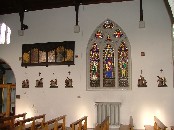 |
The chapel
is approached through glass doors that deaden all sound
once you are inside. The shrine is also simplified; the
fifteen lamps have gone. I wonder if they are now in the
Walsingham chapel at Norwich Catholic Cathedral? The
wooden entrance screen has also gone. Instead, a gorgeous
modern window of the Dream of Richeldis shines afternoon
light into the narrow space. There are two great
curiosities, modern brass figures of two of this church's
Priests. One is to George Wrigglesworth, and the other to
his predecessor, William Poole. Memorials to a glorious
past, and silent witnesses to a peaceful present.
Back in
the main part of the church, a fine west gallery has been
built in recent years; but this seems a small church for
such a busy parish. For Midnight Mass and for other
special Masses they have sometimes used the redundant
medieval town centre church of St Nicholas; and in fact
there is now a second, larger Catholic church in Kings
Lynn, Holy Family on the Gaywood estate, which was
consecrated in 1985.
The Church
of the Annunciation is a delight to visit, and it is with
sadness that I must tell you that it is kept locked,
which no Catholic church should be. But Parish Priest
Father David Finnegan is a nice man who obviously loves
his church - his presbytery is immediately to the east of
the building, and he made us very welcome.
Simon Knott, October 2005
|
|
|

